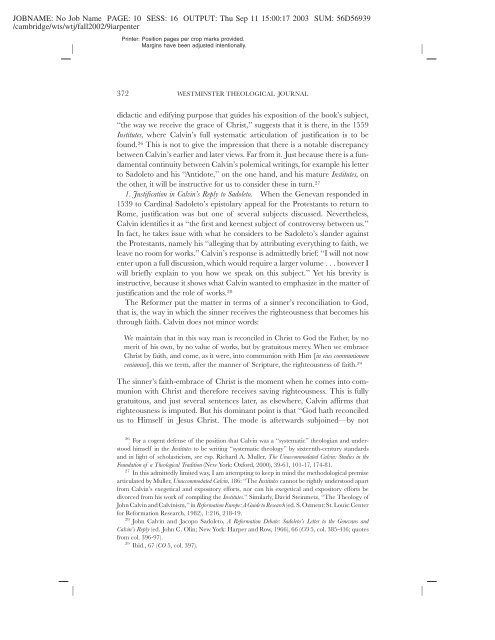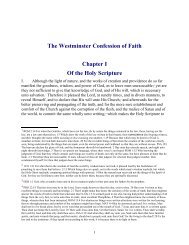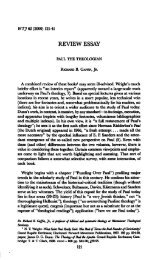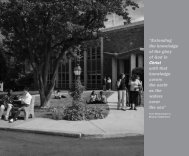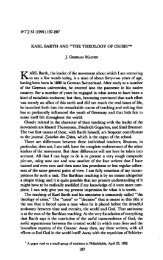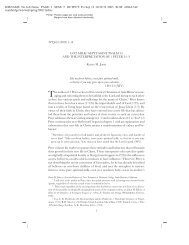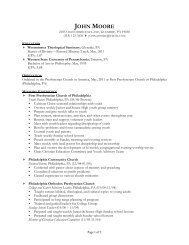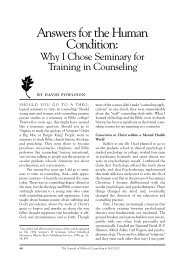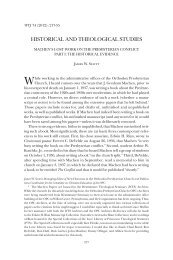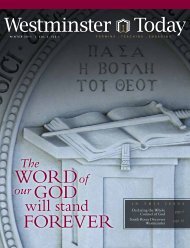A Question of Union with Christ? Calvin and Trent on Justification
A Question of Union with Christ? Calvin and Trent on Justification
A Question of Union with Christ? Calvin and Trent on Justification
Create successful ePaper yourself
Turn your PDF publications into a flip-book with our unique Google optimized e-Paper software.
JOBNAME: No Job Name PAGE: 10 SESS: 16 OUTPUT: Thu Sep 11 15:00:17 2003 SUM: 56D56939<br />
/cambridge/wts/wtj/fall2002/9ìarpenter<br />
Printer: Positi<strong>on</strong> pages per crop marks provided.<br />
Margins have been adjusted intenti<strong>on</strong>ally.<br />
372 WESTMINSTER THEOLOGICAL JOURNAL<br />
didactic <str<strong>on</strong>g>and</str<strong>on</strong>g> edifying purpose that guides his expositi<strong>on</strong> <str<strong>on</strong>g>of</str<strong>on</strong>g> the book’s subject,<br />
‘‘the way we receive the grace <str<strong>on</strong>g>of</str<strong>on</strong>g> <str<strong>on</strong>g>Christ</str<strong>on</strong>g>,’’ suggests that it is there, in the 1559<br />
Institutes, where <str<strong>on</strong>g>Calvin</str<strong>on</strong>g>’s full systematic articulati<strong>on</strong> <str<strong>on</strong>g>of</str<strong>on</strong>g> justificati<strong>on</strong> is to be<br />
found. 26 This is not to give the impressi<strong>on</strong> that there is a notable discrepancy<br />
between <str<strong>on</strong>g>Calvin</str<strong>on</strong>g>’s earlier <str<strong>on</strong>g>and</str<strong>on</strong>g> later views. Far from it. Just because there is a fundamental<br />
c<strong>on</strong>tinuity between <str<strong>on</strong>g>Calvin</str<strong>on</strong>g>’s polemical writings, for example his letter<br />
to Sadoleto <str<strong>on</strong>g>and</str<strong>on</strong>g> his ‘‘Antidote,’’ <strong>on</strong> the <strong>on</strong>e h<str<strong>on</strong>g>and</str<strong>on</strong>g>, <str<strong>on</strong>g>and</str<strong>on</strong>g> his mature Institutes, <strong>on</strong><br />
the other, it will be instructive for us to c<strong>on</strong>sider these in turn. 27<br />
1. Justificati<strong>on</strong> in <str<strong>on</strong>g>Calvin</str<strong>on</strong>g>’s Reply to Sadoleto. When the Genevan resp<strong>on</strong>ded in<br />
1539 to Cardinal Sadoleto’s epistolary appeal for the Protestants to return to<br />
Rome, justificati<strong>on</strong> was but <strong>on</strong>e <str<strong>on</strong>g>of</str<strong>on</strong>g> several subjects discussed. Nevertheless,<br />
<str<strong>on</strong>g>Calvin</str<strong>on</strong>g> identifies it as ‘‘the first <str<strong>on</strong>g>and</str<strong>on</strong>g> keenest subject <str<strong>on</strong>g>of</str<strong>on</strong>g> c<strong>on</strong>troversy between us.’’<br />
In fact, he takes issue <str<strong>on</strong>g>with</str<strong>on</strong>g> what he c<strong>on</strong>siders to be Sadoleto’s sl<str<strong>on</strong>g>and</str<strong>on</strong>g>er against<br />
the Protestants, namely his ‘‘alleging that by attributing everything to faith, we<br />
leave no room for works.’’ <str<strong>on</strong>g>Calvin</str<strong>on</strong>g>’s resp<strong>on</strong>se is admittedly brief: ‘‘I will not now<br />
enter up<strong>on</strong> a full discussi<strong>on</strong>, which would require a larger volume . . . however I<br />
will briefly explain to you how we speak <strong>on</strong> this subject.’’ Yet his brevity is<br />
instructive, because it shows what <str<strong>on</strong>g>Calvin</str<strong>on</strong>g> wanted to emphasize in the matter <str<strong>on</strong>g>of</str<strong>on</strong>g><br />
justificati<strong>on</strong> <str<strong>on</strong>g>and</str<strong>on</strong>g> the role <str<strong>on</strong>g>of</str<strong>on</strong>g> works. 28<br />
The Reformer put the matter in terms <str<strong>on</strong>g>of</str<strong>on</strong>g> a sinner’s rec<strong>on</strong>ciliati<strong>on</strong> to God,<br />
that is, the way in which the sinner receives the righteousness that becomes his<br />
through faith. <str<strong>on</strong>g>Calvin</str<strong>on</strong>g> does not mince words:<br />
We maintain that in this way man is rec<strong>on</strong>ciled in <str<strong>on</strong>g>Christ</str<strong>on</strong>g> to God the Father, by no<br />
merit <str<strong>on</strong>g>of</str<strong>on</strong>g> his own, by no value <str<strong>on</strong>g>of</str<strong>on</strong>g> works, but by gratuitous mercy. When we embrace<br />
<str<strong>on</strong>g>Christ</str<strong>on</strong>g> by faith, <str<strong>on</strong>g>and</str<strong>on</strong>g> come, as it were, into communi<strong>on</strong> <str<strong>on</strong>g>with</str<strong>on</strong>g> Him [in eius communi<strong>on</strong>em<br />
veniamus], this we term, after the manner <str<strong>on</strong>g>of</str<strong>on</strong>g> Scripture, the righteousness <str<strong>on</strong>g>of</str<strong>on</strong>g> faith. 29<br />
The sinner’s faith-embrace <str<strong>on</strong>g>of</str<strong>on</strong>g> <str<strong>on</strong>g>Christ</str<strong>on</strong>g> is the moment when he comes into communi<strong>on</strong><br />
<str<strong>on</strong>g>with</str<strong>on</strong>g> <str<strong>on</strong>g>Christ</str<strong>on</strong>g> <str<strong>on</strong>g>and</str<strong>on</strong>g> therefore receives saving righteousness. This is fully<br />
gratuitous, <str<strong>on</strong>g>and</str<strong>on</strong>g> just several sentences later, as elsewhere, <str<strong>on</strong>g>Calvin</str<strong>on</strong>g> affirms that<br />
righteousness is imputed. But his dominant point is that ‘‘God hath rec<strong>on</strong>ciled<br />
us to Himself in Jesus <str<strong>on</strong>g>Christ</str<strong>on</strong>g>. The mode is afterwards subjoined—by not<br />
26 For a cogent defense <str<strong>on</strong>g>of</str<strong>on</strong>g> the positi<strong>on</strong> that <str<strong>on</strong>g>Calvin</str<strong>on</strong>g> was a ‘‘systematic’’ theologian <str<strong>on</strong>g>and</str<strong>on</strong>g> understood<br />
himself in the Institutes to be writing ‘‘systematic theology’’ by sixteenth-century st<str<strong>on</strong>g>and</str<strong>on</strong>g>ards<br />
<str<strong>on</strong>g>and</str<strong>on</strong>g> in light <str<strong>on</strong>g>of</str<strong>on</strong>g> scholasticism, see esp. Richard A. Muller, The Unaccommodated <str<strong>on</strong>g>Calvin</str<strong>on</strong>g>: Studies in the<br />
Foundati<strong>on</strong> <str<strong>on</strong>g>of</str<strong>on</strong>g> a Theological Traditi<strong>on</strong> (New York: Oxford, 2000), 39-61, 101-17, 174-81.<br />
27 In this admittedly limited way, I am attempting to keep in mind the methodological premise<br />
articulated by Muller, Unaccommodated <str<strong>on</strong>g>Calvin</str<strong>on</strong>g>, 186: ‘‘The Institutes cannot be rightly understood apart<br />
from <str<strong>on</strong>g>Calvin</str<strong>on</strong>g>’s exegetical <str<strong>on</strong>g>and</str<strong>on</strong>g> expository efforts, nor can his exegetical <str<strong>on</strong>g>and</str<strong>on</strong>g> expository efforts be<br />
divorced from his work <str<strong>on</strong>g>of</str<strong>on</strong>g> compiling the Institutes.’’ Similarly, David Steinmetz, ‘‘The Theology <str<strong>on</strong>g>of</str<strong>on</strong>g><br />
John <str<strong>on</strong>g>Calvin</str<strong>on</strong>g> <str<strong>on</strong>g>and</str<strong>on</strong>g> <str<strong>on</strong>g>Calvin</str<strong>on</strong>g>ism,’’ in Reformati<strong>on</strong> Europe: A Guide to Research (ed. S. Ozment; St. Louis: Center<br />
for Reformati<strong>on</strong> Research, 1982), 1:216, 218-19.<br />
28 John <str<strong>on</strong>g>Calvin</str<strong>on</strong>g> <str<strong>on</strong>g>and</str<strong>on</strong>g> Jacopo Sadoleto, A Reformati<strong>on</strong> Debate: Sadoleto’s Letter to the Genevans <str<strong>on</strong>g>and</str<strong>on</strong>g><br />
<str<strong>on</strong>g>Calvin</str<strong>on</strong>g>’s Reply (ed. John C. Olin; New York: Harper <str<strong>on</strong>g>and</str<strong>on</strong>g> Row, 1966), 66 (CO 5, col. 385-416; quotes<br />
from col. 396-97).<br />
29 Ibid., 67 (CO 5, col. 397).


